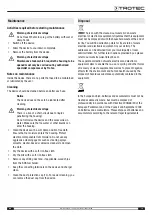
EN
16
Operating manual – cordless rotary hammer PRDS 10-20V
Maintenance
Activities required before starting maintenance
Warning of electrical voltage
Do not touch the mains plug or the battery with wet or
damp hands.
•
Switch off the device.
•
Allow the device to cool down completely.
•
Remove the battery from the device.
Warning of electrical voltage
Maintenance tasks which require the housing to be
opened must only be carried out by authorised
specialist companies or by Trotec.
Notes on maintenance
Inside the device, there are no parts that need to be maintained
or lubricated by the user.
Cleaning
The device should be cleaned before and after each use.
Notice
The device does not have to be lubricated after
cleaning.
Warning of electrical voltage
There is a risk of a short-circuit due to liquids
penetrating the housing!
Do not immerse the device and the accessories in
water. Make sure that no water or other liquids can
enter the housing.
•
Clean the device with a soft, damp and lint-free cloth.
Ensure that no moisture enters the housing. Protect
electrical components from moisture. Do not use any
aggressive cleaning agents such as cleaning sprays,
solvents, alcohol-based or abrasive cleaners to dampen
the cloth.
•
Dry the device with a soft, lint-free cloth.
•
Dry the bits with a soft, lint-free cloth.
•
Remove any drilling dust and, if applicable, wood chips
from the SDS tool holder.
•
Keep the connecting terminals on the device and charger
clean.
•
Clean the dust protection cap (14). For easier cleaning, you
can remove the dust cap from the device.
Disposal
The icon with the crossed-out waste bin on waste
electrical or electronic equipment stipulates that this equipment
must not be disposed of with the household waste at the end of
its life. You will find collection points for free return of waste
electrical and electronic equipment in your vicinity. The
addresses can be obtained from your municipality or local
administration. For further return options provided by us please
refer to our website www.trotec24.com.
The separate collection of waste electrical and electronic
equipment aims to enable the re-use, recycling and other forms
of recovery of waste equipment as well as to prevent negative
effects for the environment and human health caused by the
disposal of hazardous substances potentially contained in the
equipment.
Li-Ion
In the European Union, batteries and accumulators must not be
treated as domestic waste, but must be disposed of
professionally in accordance with Directive 2006/66/EC of the
European Parliament and of the Council of 6 September 2006
on batteries and accumulators. Please dispose of batteries and
accumulators according to the relevant legal requirements.
































